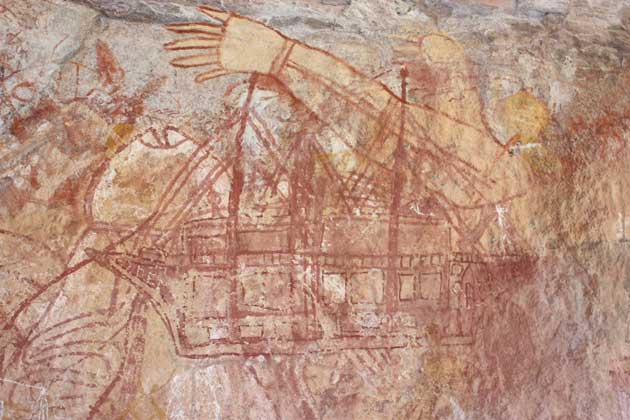Australian history rewritten in rock art
Cave paintings made over thousands of years – up until the 20th century – challenge the stereotypical view of Aboriginal people

Arnhem Land, jutting into the Arafura Sea at the top of Australia, has always been a special place for Aboriginal people. Just how special has been reinforced by the discovery of an extraordinary collection of rock art recording life in the area for the past 15,000 years, up until 50 years ago.
Alongside ancient paintings of thylacines, a mammal long extinct on the mainland, are images documenting modern-day inventions – a car, a bicycle wheel, a biplane and a rifle – as well as portraits of a missionary and a sea captain. Scientists documenting the rock art, spread across at least 100 sites in the remote Wellington Range, say it ranks among the world's finest.
It also appears to rewrite Australian history, undermining the widely held assumption that the continent was isolated and largely unvisited until the First Fleet arrived in 1788. The paintings suggest that, on the contrary, the people of northern Australia have been interacting with seafaring visitors from Asia and Europe for hundreds, possibly thousands, of years.
A team of scientists on a recent expedition to the Wellington Range recorded 81 images of ships, ranging from the vessels of Macassan traders from Sulawesi (now part of Indonesia) to dugout canoes, 19th-century British tall ships, 20th-century steamers and Japanese pearling luggers. They even found paintings of a luxury cruise ship and a Second World War destroyer.
Twentieth-century rock art is extremely rare anywhere, and the scientists surveying the paintings with the help of a local Aboriginal elder, Ronald Lamilami, say they represent possibly the longest continuous record in the world.
"This seems to have been a key location where people went back again and again, adding to the art over thousands of years and many hundreds of generations," Professor Paul Tacon, an archaeologist from Griffith University in Queensland, said last week. "Each time they went back, they added new imagery and new experiences to the growing history book that they were creating. Many Aboriginal people across northern Australia describe these sorts of sites as their history books, or libraries."
The rock art has been known about since the 1970s, when a leading expert, George Chaloupka, was taken to the area by local people. But he saw only a tiny proportion of it, and records of its whereabouts were lost. It was only recently that they were rediscovered by a doctoral student, Daryl Guse, working with Mr Lamilami. Professor Tacon's team, which travelled to Arnhem Land last month, was overwhelmed by the sheer volume of the art, much of which had never before been viewed by white people. In one rock shelter alone, they found 1,500 paintings, comprising "more 'contact era' art and more varied imagery than any other site in the world", according to Professor Tacon.
"This area is astounding," he said. "Every time we went out, we had a plan to survey a particular stretch of the range, but we could hardly move at all, because we were continually finding sites. Over a few days, we found 100 previously undocumented sites, and we've only just scratched the surface. There are hundreds, possibly thousands, of sites waiting to be revealed to the outside world. This area is of World Heritage significance, and it rivals the best of any area in Australia. It's right up there with the best rock art regions of Europe and South Africa and elsewhere."
The art contains subjects and styles not found elsewhere in Australia. Much of it consists of multiple layers applied over the millennia. On one wall, for instance, is a biplane painted over a kangaroo. One early depiction of a ship includes a wealth of interior detail, suggesting that Aboriginal people had been boarding vessels for generations. So, when the British arrived, Professor Tacon speculates, "it was not something bizarre and unusual; it was just the latest group in their latest newfangled ships".
Subscribe to Independent Premium to bookmark this article
Want to bookmark your favourite articles and stories to read or reference later? Start your Independent Premium subscription today.

Join our commenting forum
Join thought-provoking conversations, follow other Independent readers and see their replies